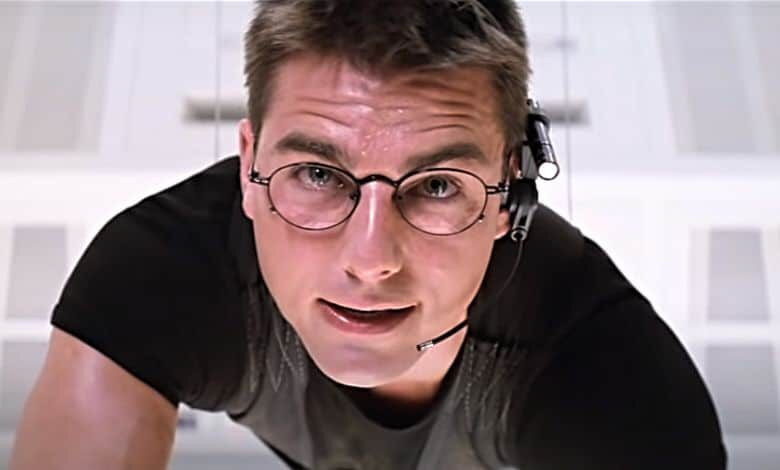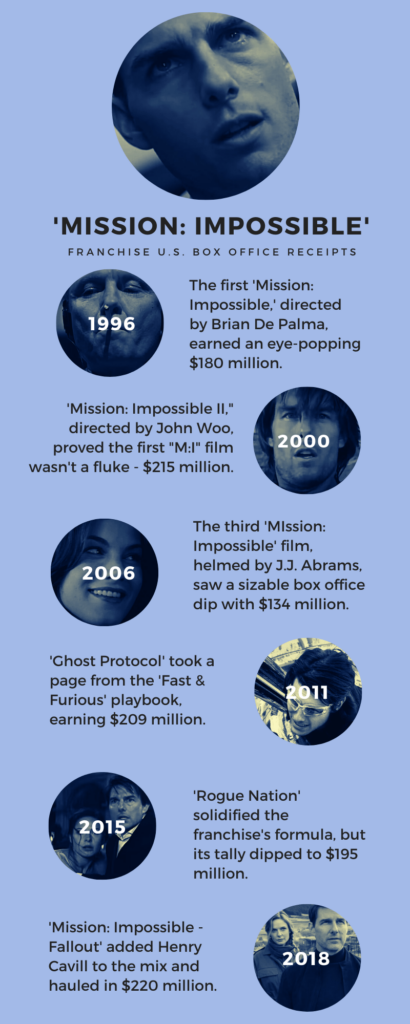
The term “elegant” isn’t one often used to describe summer movies, but it’s the word that comes to mind the quickest when I think of Brian De Palma’s “Mission: Impossible.”
The first in a long franchise (with the seventh and eighth installments scheduled to open this year and the next), De Palma’s film was a monster success, monetarily and artistically, though it continues to be a heavily debated work.
Does the first in the long line of “M:I” films really hold up and, its biggest complaint from detractors, does the plot actually make any sense? The answers to both questions is yes. An opportunity to revisit this, should you choose to accept it, is a chance to witness just how fantastic it still is.
In this adaptation of Bruce Gellar’s 1966 television series, Jon Voight stars as Jim Phelps (Peter Graves in both the original series and the ’80s revival), the leader of the Impossible Mission Force. These secret agents take on assignments that are, well, impossible.
Among those aiding Phelps are Claire, his wife (Emmanuelle Beart), Sarah, a skillful actress (Kristin Scott Thomas), Jack, a tech wizard (Emilio Estevez) and a smarmy master of disguises named Ethan Hunt (some guy named Tom Cruise).
As the team’s mission goes from being an ambush to a massive tragedy, Ethan finds himself the sole survivor. He flees the scene of the crime, finds a payphone and, with blood stained on his visibly shaking hands, calls his superior, Kittridge (Henry Czerny, so perfect in this).
While Kittridge attempts to calm Ethan and take in the details, Hunt is panicked (“They’re dead, they’re ALL DEAD!”) and coming unglued. It’s a great scene. and the reason why this, by far, is my favorite in the franchise; whereas Hunt becomes impenetrable and unflappable with each subsequent installment, there’s an unsteadiness here, a vulnerability that brings out the best in Cruise.
RELATED: ‘Mission: Impossible – Fallout’ Offers Even More Stunning Action
Yes, I love the sequels (well, the third one is just all right) and enjoy Cruise’s current status as Superhero Mega Action Movie Star, but he used to be an actor, too.
His best films (a long list that includes “Eyes Wide Shut,” “Rain Man,” “Magnolia,” “Jerry Maguire,” “Minority Report” and “Born on the 4th of July”) showcase his ability to play men struggling to regain the control they once had over their lives.
While it clearly has benefitted him from being known lately for the grand insanity of the stunts he performs, Cruise has always been an arresting, risk-taking actor. I miss the Tom Cruise who used to play men who were not impervious to pain and the laws of gravity but were recognizably human and intriguingly flawed.
Those qualities are here.
Yes, Hunt is clearly being positioned as an American James Bond (Cruise even dons a tux early on) but the character is an arrogant but efficient agent who suddenly finds that everything he’s been taught no longer works for him.
In the laid-back early scene of the team casually sitting around as Phelps lays out their upcoming mission, Hunt’s line, “Wouldn’t have it any other way,” exudes a Maverick-like cockiness from Cruise, which is all but gone by the second act.
De Palma’s trademark visuals and even his dark themes of surveillance and voyeurism are in plain view from the opening moments. We get a pre-credit prolog in which a fake out has been presented in a sordid manner (apparently, Beart is pretending to be a dead hooker).
De Palma’s Dutch angles, obtrusive close-ups and slow pans put us into this exhilarating but uneasy world immediately. The opening titles are a frantic montage of scenes from the film we’re about to watch (!), which would be a spoiler if they didn’t go by so fast (Lalo Schifrin’s roaring classic theme gets the blood pumping and further distracts from the frantic assemblage of imagery).
From top to bottom, De Palma’s cinematic wizardry is all over this, his best big budget studio film (yes, it’s better than “The Untouchables”).
A mid-point heist sequence, in which Hunt demands from his team (and us) “absolute silence,” is possibly the film’s most iconic (namely that shot of Hunt hovering inches off the floor) and pure cinema. Here, De Palma got audiences to lean forward, watch carefully and shut up long before “A Quiet Place” did the same thing.
Everyone in the cast is in their element and, like “Jerry Maguire” the same year, Cruise is generous in allowing the ensemble to shine and occasionally upstage him. Czerny is so good here, it’s a wonder his Kittridge was never brought back in later installments (though he’s rumored to pop up in the currently- filming seventh entry).
Voight brings many layers to the role made famous by Graves and it gives the actor a juicy part, one of many in 
All right, I’ll mention “Anaconda,” too.
Beart, in her lone big-budget American film, is a dazzling femme fatale, Scott Thomas registers strongly as a member of Phelps’ team (she appeared in this the same year she starred in “The English Patient”), the always-enjoyable Ving Rhames brings much charm to a post-“Pulp Fiction” role that he would return to often.
Jean Reno adds some nice moments of humor as a disavowed agent for hire, Vanessa Redgrave is terrific as a flirtatious arms dealer and an unbilled Emilio Estevez (co-starring with Cruise for the first time since “The Outsiders”) is delightful in a memorable supporting bit.
De Palma mimics Hitchcock not merely in the design of several key sequences but in the shock of killing off one of the most likable characters early on.
The screenplay (credited to everyone from Steve Zaillian, David Koepp and Robert Towne) is hard to follow at times but De Palma makes this spellbinding. Admittedly, I saw this three times in the theater, and it wasn’t until the third time that everything in the plot finally clicked together. By viewing this more than one, you’ll catch all the smart foreshadowing.
Like Michael Mann’s “Miami Vice” or Christopher Nolan’s “Tenet,” it’s a simple plot that’s presented in a confusing manner, in order to throw off the obvious red herrings. Multiple viewings not only help piece it all together but reveal some clever foreshadowing.
The plot is like a John Le Carre yarn infused with Ian Fleming, with post-Cold War moral duplicity and cloak and dagger types considering alternate career paths at the expense of those closest to them.
The scene that baffled most audience members (this one included) is the chilling flashback where Hunt pieces together what happened during the brutal ambush and mass murder of his IMF teammates. As the words of the storyteller contradict the actions we witness, we have to piece together the truth and register the feeling of betrayal Hunt is carefully concealing.
Remarkably, the special effects during the well-remembered, climactic bullet train sequence hold up, as Industrial Light & Magic makes it really look like Cruise really on the roof of that passenger car (of course, if this was made today, he would probably do it for real).
An underappreciated aspect is Rob Bottin’s special make-up effects, which creates elaborate disguises for Cruise to wear and perform (Cruise’s appearance in “Tropic Thunder” and his ability to perform under layers of make-up should come as no surprise if you watch this first).
Perhaps the film’s greatest asset is the brilliant cinematographer Stephen H. Burum, who is also responsible for filming “The Outsiders,” “Something Wicked This Way Comes,” “The War of the Roses” and “Carlito’s Way” (as well as other subsequent De Palma works).
In addition to the film’s many signature visuals (like the slow pan of Hunt removing a pair of glasses or Hunt’s incredible slow-motion dash from a wall of water), there’s an overhead shot of Hunt frantically searching his bathroom suite for stashed funds.
The camera is overhead and reaches into the ceiling, a precursor to the jaw-dropping, hotel room overview sequence from De Palma’s following “Snake Eyes.” Through De Palma’s ambitious choreography, Burum does some amazing things here.
If anything dates this, it’s the technology on view, captured during the early days of the Internet. Watching emails being carefully worded reminded me of how exotic Hotmail once seemed. Inevitably, the tech on hand is now retro, though the most antiquated touches are an unobtrusive use of The Cranberries’ “Dreams” and a mockup of “The McLaughlin Group.”
Redgrave’s arms dealer, who goes by “Max” online, tells Hunt, “I can’t tell you what a comfort anonymity can be in my profession…it’s like a warm blanket.” Redgrave gives the line a delicious kick, but the character is also speaking to the appeal of the Internet, which was just about to take over the world.
In fact, while “Stargate” is the first film to ever have its own official website, “Mission: Impossible” was the first time I can recall that a major studio made a lavish effort to showcase a film online.
Of course, this was back when the perks of a movie website were simply some bios, typed behind the scenes anecdotes, photos and a Quicktime trailer that took an hour to download.
Ah, the ’90s.
De Palma’s “Mission: Impossible” was originally set for a Christmas of 1995 release (a slot that Harrison Ford’s “Sabrina” remake took over) but was wisely positioned for a big 1996 summer unveiling. It was a smart choice, as it not only proved a massive blockbuster (even the Larry Mullen, Jr. and Adam Clayton remix of the theme song was a top ten hit!), but this also nicely sets up the franchise at the end without overdoing it.
Compared to what came after, the contrast is telling.
Here, Hunt declares “zero body count” and never fires his gun, unlike the bullet-crazy (and still pretty fantastic) John Woo-helmed 2000 follow-up. Kittridge states of the IMF that “we trained these guys to be ghosts,” a nice connection to the eventual franchise revival “Mission Impossible: Ghost Protocol.”
The first “Mission: Impossible” is perplexing but always exciting, displaying the kind of brilliant film craftsmanship, class and narrative layers that only Christopher Nolan achieves today. Twenty-five years ago, it was the start of one of the most successful franchises ever produced by Paramount Pictures.
While some longtime fans may prefer what the villain of the second film refers to as Cruise’s “acrobatic insanities,” De Palma’s movie, and not the missions that followed, is the one I choose to accept.
